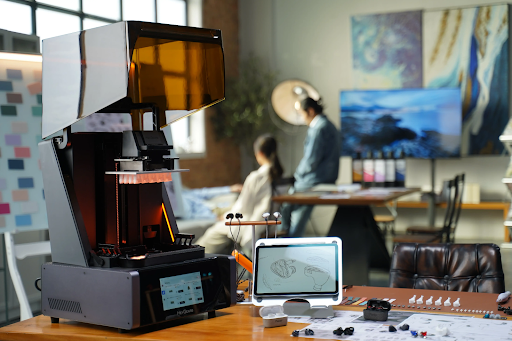The stunning detail and smooth surface quality of resin 3D printing have captivated countless entrepreneurs. However, turning that passion into a successful business is far more complex than just hitting print. Before you invest your time and money, confront these hard truths.
Truth #1: The Printer Is Just the Tip of the Iceberg
Many people assume the printer is the biggest expense. While a high-quality resin 3D printer (like those from HeyGears, which specializes in rapid prototyping and miniatures) is a significant initial investment, the true costs run much deeper:
- Post-Processing Equipment: You will need dedicated washing and curing stations, which are a considerable extra expense.
- Consumables: Resin, isopropyl alcohol (IPA) or other cleaning solvents, lint-free cloths, gloves, and filters are all recurring costs.
- Time Cost: A single print can take hours, but the time you spend on model preparation, adding supports, and post-processing can often take even longer.
The Bottom Line:
When building your business plan, factor in all these hidden costs. Your true ROI is based on your total investment, not just the printer’s price tag.
Truth #2: Post-Processing, Not Printing, Is the Real Bottleneck
The magic of resin printing is its precision, but this is also the source of its biggest headaches. The model that comes off the printer is just a semi-finished product: it’s sticky, fragile, and covered in uncured resin.
- The Tedious Workflow: Washing, support removal, and final curing—each step demands patience and skill. Improper cleaning can ruin a model’s surface, while incorrect curing can compromise its final properties.
- Safety and Environmental Hazards: Uncured resin and used cleaning solvents are chemical waste and require proper disposal, adding complexity and cost to your operations.
The Bottom Line:
Standardize your post-processing workflow and treat it as a core part of production. Choosing a brand like HeyGears, which offers an integrated ecosystem from printing to post-processing, can significantly lower the learning curve and improve output consistency.
Truth #3: Your Value Is in Design, Not Just Printing
The market is flooded with basic print-on-demand services. If all you offer is printing other people’s files, you will quickly be trapped in a price war. What clients truly pay for is your unique design talent and problem-solving ability.
- Where the Value Lies: Can you design a clever, print-optimized miniature for a client? Can you take a vague concept and quickly create a functional prototype for validation?
- Your Competitive Moat: A deep understanding of material properties (e.g., toughness, temperature resistance, biocompatibility) and process knowledge for different applications (e.g., jewelry casting, dental models) is what will make you irreplaceable.
The Bottom Line:
Continuously invest in your and your team’s design skills. Build your own library of models or offer custom design services to transition from a print operator to a solution provider.
Truth #4: Resin Is Both a Blessing and a Curse
The vast array of photosensitive resins, each with different properties, is what makes the technology so powerful. But it also means:
- A Steep Learning Curve: Every resin has different characteristics (shrinkage, exposure time, and mechanical strength) and requires extensive testing and experience to master.
- Storage and Shelf Life: Resins have an expiration date and are sensitive to light and air, requiring strict storage conditions. Performance can degrade after opening, leading to waste.
- Unpredictable Costs: Specialty resins (like high-toughness or high-temperature) are extremely expensive and can directly squeeze your profit margins.
The Bottom Line:
Start by mastering a few of the most versatile and stable resins. Don’t try to offer every material; instead, choose strategically based on your target market (e.g., standard resins for miniatures, engineering resins for prototypes).
Truth #5: If You Serve Everyone, You Serve No One
3D printing is a broad field. Trying to be everything to everyone will leave you exhausted and make it impossible to build a strong reputation. Successful businesses are highly focused.
- Find Your Niche: Are you a specialist who paints tabletop gaming miniatures? A rapid prototyping expert for jewelry designers? A service that provides proof-of-concept models for engineers?
- Targeted Marketing: Once you’ve defined your niche, all your marketing, portfolio pieces, and client communication should be centred around it.
The Bottom Line:
Before launching, invest significant time in market research. Find a niche where you have both passion and a professional advantage, and then become the go-to expert in that field.
Truth #6: Consistency and Scalability Are the Ultimate Hurdles
Successfully printing one small model doesn’t mean you can reliably handle bulk orders. The real test comes when orders start piling up.
- The Consistency Puzzle: How do you ensure that the 100th print has the exact same quality as the first?
- Production Bottlenecks: A single printer has limited capacity. Adding more machines means multiplying your costs, space requirements, and management complexity.
- Workflow Chaos: Juggling multiple orders simultaneously makes project management, progress tracking, and client communication incredibly complex.
The Bottom Line:
Establish strict Standard Operating Procedures (SOPs) from day one. Invest in efficiency tools like queue management software and HeyGears Reflex RS 3D printer, you can enjoy the great convenience brought by stable Z-axis operation and screen calibration light intensity. . Before you scale, ensure your business model is proven, viable, and profitable.
Conclusion
Resin 3D printing is a magical technology that turns ideas into reality, but the path to a successful business is challenging. Recognizing these harsh truths isn’t meant to discourage you, but to ensure you start your journey with clear eyes and full preparation. Success belongs not to the merely passionate but to the pragmatists who can masterfully blend technical depth, design talent, and business acumen.
When you treat these challenges as stepping stones and solve problems with professionalism, your 3D printing business can truly evolve from prototyping to production, and from a hobby into a thriving enterprise.
NOTE:
The Essential Role of Energy Storage Systems in Business
Energy storage systems are quietly becoming the backbone of resilient, cost-effective business operations — they smooth out grid fluctuations, cut peak energy bills, and let companies keep critical services running during outages. For managers and teams planning growth, investing in storage means greater control over energy costs and a clearer path to sustainability goals, whether you’re running a factory, a data center, or a small retail chain. If you want practical examples or a quick case study to help convince stakeholders, visit here — it explains how one business turned a modest battery installation into predictable savings and better customer service.
Sungrow AU Inverters in Australia: Innovating Energy Solutions for Businesses
Sungrow AU inverters are helping Australian businesses unlock smarter, more reliable energy — turning rooftop solar and battery storage into predictable cost savings and cleaner operations. From small retail shops to industrial warehouses, their compact design, real-time monitoring, and easy scalability mean fewer surprises on your power bills and more uptime for your equipment. If you’d like practical examples, installation tips, or a quick checklist to evaluate whether a Sungrow system suits your site, visit here blew link. Have questions about your specific setup? Leave a comment or contact us and we’ll walk through the options together.



